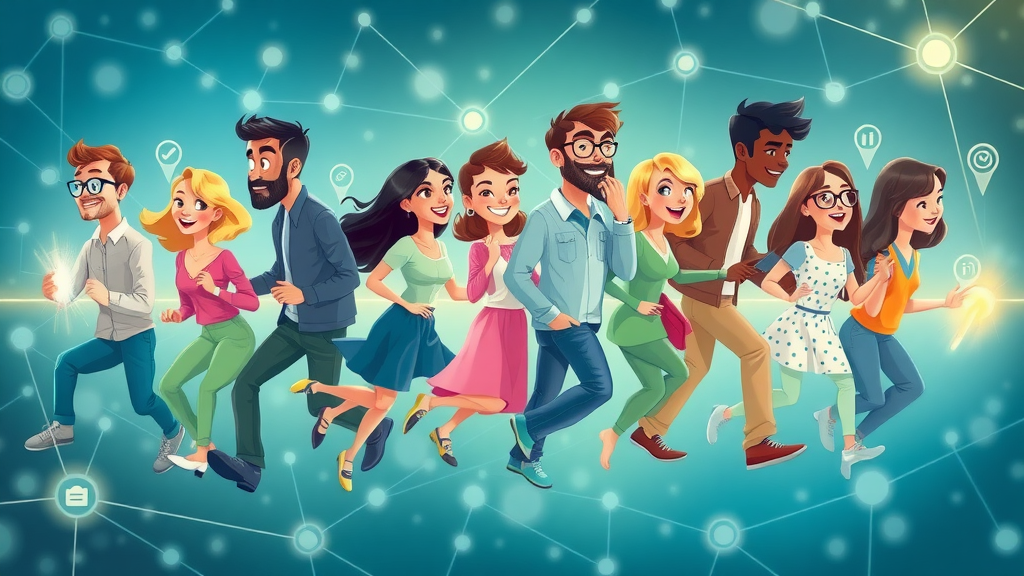Did you know that businesses with high customer engagement online can enjoy up to 63% lower churn rates? In today’s digital landscape, building a loyal customer base isn’t just about selling great products or services—it’s about how you connect, nurture, and delight customers across every digital touchpoint. Whether you’re a small brand or a global enterprise, mastering digital customer engagement is your path to lasting loyalty and sustainable business growth.

Unlocking the Power of Customer Engagement Online: Surprising Facts Every Brand Should Know
- Did you know businesses that excel at customer engagement online experience 63% lower churn rates? Explore why customer engagement online isn’t optional—it’s critical to brand success.
Customer engagement online is not just a trendy buzzword—it's a business necessity. Modern customers expect meaningful, real-time interactions across any digital channel, whether it’s via social media, live chat, or apps. When brands make digital engagement a strategic priority, they foster a loyal customer base that is far more likely to stick around, advocate for the brand, and spend more over time.
Industry data shows that a robust customer engagement strategy leads to higher customer satisfaction, unsolicited word-of-mouth marketing, and quantifiable growth in retention and revenue. As digital channels continue to multiply, brands must rethink how they connect to ensure every digital customer experience is positive, seamless, and memorable.
What You Need to Know: Mastering Customer Engagement Online
- You’ll learn how customer engagement online influences customer loyalty and satisfaction;
- Key digital customer engagement strategies for your business;
- How top brands use customer engagement platforms for superior results;
- Step-by-step actions to nurture long-term customer relationships online.
In this in-depth guide, we’ll explore the foundation of customer engagement online, examining real-world strategies that foster loyal customers and strengthen long-term customer relationships . You’ll uncover the secrets behind digital customer journeys, find inspiration from powerful engagement platforms, and gain actionable insights every business can use. We’ll also illuminate common challenges—and deliver expert tips that turn digital engagement obstacles into opportunities. Let’s dive in and reimagine what’s possible for your digital customer experience.
Understanding Customer Engagement Online: Definitions, Importance, and Digital Evolution
What is Customer Engagement Online and Why Does It Matter?
"Every interaction, no matter how small, is an opportunity to win a customer’s loyalty in the digital world." — Industry Thought Leader
Customer engagement online refers to every meaningful interaction between your business and customers across digital channels —whether that’s a social media reply, live chat, app notification, or a seamless purchase journey. It is about forging emotional connections, gathering customer feedback , and delighting end-users at every step.
In the age of hyper-connectivity, brands can no longer afford passive customer relationships. Every digital touchpoint is a moment to inspire, help, or delight. Consistent, authentic engagement increases customer loyalty and reduces the risk of losing your audience to competitors. This is why a customer-centric engagement strategy is integral to brand longevity.

Digital Customer Journeys: Mapping the Modern Customer Experience
Understanding the digital customer journey is the foundation of successful online engagement. Today’s customers interact with brands through a variety of touchpoints—websites, mobile apps, social media, live support, and more. Mapping this journey helps businesses anticipate needs, resolve pain points, and create fluid, impactful customer experiences .
By identifying the moments that matter most (from the first website visit to post-purchase support), brands can personalize messages and offers, making customers feel valued and understood. This practice pays dividends in customer satisfaction , retention, and the creation of loyal customers who come back again and again.

Key Elements of Successful Digital Customer Engagement
Customer Engagement Strategy: Crafting a Roadmap for Success
A winning customer engagement strategy requires deliberate planning and alignment with your brand’s values and customer expectations. Effective engagement strategies clarify your goals (such as raising the customer satisfaction score or boosting customer retention ) and outline the preferred digital channels and tools to reach your audience.
Start by auditing your current engagement touchpoints. Are you leveraging every possible digital channel —from email to social media—to connect with your audience? Next, identify pain points in the customer journey and address them with quick-win solutions like live chat or personalized follow-ups. Lastly, establish metrics (such as Net Promoter Score or lifetime value) to track your progress and inform future improvements.

Harnessing Customer Engagement Platforms for Omnichannel Experiences
To deliver a seamless omnichannel digital experience, many leading brands turn to a customer engagement platform . These platforms integrate all customer interaction points— social media , email, SMS, web chat, and more—under a single dashboard, making it easier to deliver consistent communication and gather valuable customer data .
A top-tier engagement platform allows businesses to automate marketing campaigns, manage customer feedback, and personalize content at scale. This not only boosts customer loyalty but also ensures that customers receive timely, relevant support and offers, wherever they are in their journey. The result? An elevated brand experience that keeps loyal customers engaged and eager to spread the word.
Top Customer Engagement Strategies for Online Success
Leveraging Social Media for Digital Engagement
Social media platforms are powerful tools for building and sustaining customer engagement online . Platforms like Instagram, Facebook, Twitter, and LinkedIn offer countless opportunities for real-time conversations, feedback collection, and viral brand advocacy. Engaged digital customers who interact with your posts, stories, and live streams not only stay loyal but often become brand ambassadors.
Best practices for social media engagement include posting consistent, relevant content, responding quickly to messages, and using interactive features like polls and Q&As. Incorporate user-generated content to humanize your brand and recognize loyal customers. Aim to create a welcoming space where the community feels heard, inspired, and connected.

Personalized Customer Experiences: From Data to Delight
Personalization is the heart of modern digital customer engagement . By harnessing customer data —such as browsing behavior, purchase history, and preferences—brands can deliver content tailored to individual needs, making each customer feel unique and valued.
Think beyond using first names in emails. Offer personalized experiences by recommending products and services based on previous actions, sending targeted offers on special occasions, or even curating exclusive content for segments of your customer base . Data-driven personalization drives higher customer satisfaction , greater engagement, and a deeper sense of brand loyalty.
Building Customer Loyalty through Loyalty Programs and Community Building
A well-crafted loyalty program not only incentivizes repeat purchases but also strengthens the emotional bond between your brand and your customers. Offer points, rewards, or exclusive access in exchange for ongoing engagement—be it making purchases, sharing feedback, or participating in online events.
Consider building a digital community where loyal customers can connect, share ideas, and find support. This fosters a sense of belonging and transforms one-time buyers into true brand advocates . Incorporate feedback loops so that every customer knows their voice matters, encouraging them to stay engaged far beyond the initial transaction.

Exceeding Customer Expectations to Increase Satisfaction and Retention
Delivering more than what your customers expect is a fundamental principle of high-impact digital engagement . From responding promptly on live chat to resolving issues proactively, every interaction must be designed to surprise and delight.
Look for ways to go the extra mile—personal thank-you messages, bonus content, or spontaneous discounts can make a huge difference in customer satisfaction . By setting and exceeding expectations, brands boost customer retention , turning satisfied clients into enthusiastic, long-term loyal customers.
Digital Customer Engagement Platforms: Comparing Industry Leaders
| Platform | Key Features | Integration | Pricing | Customer Support |
|---|---|---|---|---|
| HubSpot | CRM, Email Automation, Live Chat, Social Media Integration | Seamless with major digital channels | Free–Premium | 24/7 Live Support |
| Zendesk | Ticketing, Messaging, Omnichannel Analytics | Integrates with 100+ apps | Starter–Enterprise | Global Email & Chat Support |
| Salesforce Service Cloud | AI-Driven Cases, Social Customer Service, Analytics | Strong CRM, third-party integration | Subscription-based | 24/7 Phone & Online |
| Intercom | Conversational Messaging, Bots, Knowledge Base | APIs, leading marketing tools | Custom Pricing | In-App & Email |
Customer Experience in the Age of Digital Transformation
Enhancing Customer Satisfaction with Every Click
Every interaction is a chance to deliver value and foster customer satisfaction . As digital transformation accelerates, brands must ensure their digital channels are intuitive, responsive, and optimized for every device.
Simple improvements, like reducing website load times, offering 24/7 support through chatbots, and ensuring mobile-friendliness, can elevate the overall customer experience . Continuously gathering feedback and using analytics to find friction points enables businesses to address issues before they affect loyalty or retention.

Driving Customer Retention through Data-Driven Personalization
Retention is significantly higher when companies use customer data to deliver personalized experiences and proactive service. By leveraging behavioral data (such as website activity or purchase history), brands can engage customers with relevant content and timely offers that match their preferences.
This level of personalization boosts trust and loyalty, increasing the likelihood of repeat purchases and long-term engagement. Track which campaigns drive the most engagement and use these insights to progressively refine your outreach for maximum impact.
Case Study: Brands That Transformed Loyalty with Digital Customer Engagement
Leading brands like Starbucks and Nike have set new standards in digital customer engagement by using omnichannel platforms and creative loyalty programs. Starbucks, for example, leverages its app for personalized recommendations, digital rewards, and mobile payments—engaging loyal customers before, during, and after their visit.
Nike’s digital community offers members personalized content, fitness challenges, and unique experiences, all helping to create deeper customer relationships and advocacy. These brands prove that when you prioritize the entire customer journey and invest in digital engagement, you build a base of loyal fans eager to champion your business.
Common Challenges in Customer Engagement Online—and How to Overcome Them
- Maintaining Consistency Across Platforms
- Personalization at Scale
- Measuring the ROI of Engagement Strategies
- Handling Negative Customer Experiences
While the benefits of customer engagement online are clear, brands often face real-world obstacles—fragmented digital channels, limited personalization resources, and the challenge of proving ROI. Responding to negative feedback or complaints requires sensitivity and a commitment to transparency.
Overcoming these challenges starts with unified digital tools, cross-functional team training, and a feedback-driven approach. Empower frontline staff, automate wherever possible, and always be ready to pivot when customer behavior signals a shift in expectations.
Expert Tips for Solving Customer Engagement Obstacles
"Personalization isn’t just a digital tactic—it’s a competitive advantage in achieving superior customer engagement online."
To overcome personalization challenges, invest in platforms with robust data analytics and automation. For omni-channel consistency, use a single source of customer data and establish clear brand voice guidelines. Address negative customer experiences swiftly and empathetically—turning challenges into opportunities for improved customer relationships and advocacy.
Finally, set clear KPIs for your engagement strategy and review them regularly to measure progress. When issues arise, leverage customer insights to improve processes and maintain your reputation for stellar customer service .
Innovative Engagement Strategies: Creating Loyal Customers Online
- Interactive Content and Gamification
- Real-Time Support and Chatbots
- Community Engagement Initiatives
- User-Generated Content and Brand Advocacy
Successful brands are innovating with real-time support, gamified loyalty programs, community-driven projects, and by tapping into the power of user-generated content. Games, quizzes, and contests engage customers and encourage sharing, while chatbots deliver instant support 24/7 across all key digital channels .
Establishing active online communities allows customers to support each other, enhancing overall customer satisfaction and brand trust. Recognizing top contributors and advocates can inspire even more participation, deepening loyalty and amplifying your reach.

Measuring the Impact of Your Customer Engagement Online
KPIs and Metrics for Digital Customer Engagement
| Metric | Definition | Why It Matters |
|---|---|---|
| Customer Satisfaction Score (CSAT) | Percentage of positive ratings after digital interactions | Directly reflects the perceived quality of your digital customer experience |
| Net Promoter Score (NPS) | Likelihood customers will recommend your business | Indicates loyalty and potential for advocacy |
| Retention Rate | Percentage of return customers over time | Measures engagement strategy effectiveness in fostering loyalty |
| Customer Lifetime Value (CLV) | Total net profit from a single customer relationship | Reveals long-term impact of personalized experiences and loyalty programs |

Optimizing Engagement Strategies for Long-Term Growth
Continuous improvement is vital for sustained digital engagement . Use analytics to track which strategies increase customer satisfaction and retention, then double down on what works best. Experiment with new channels and content formats, but always review outcomes against your defined KPIs.
Regularly solicit feedback from your customer base , adapting your messaging and timing to meet their evolving needs. This relentless pursuit of excellence sharpens your brand experience, attracts new digital customers, and keeps loyal customers coming back—year after year.
Expert Insights: Future Trends in Customer Engagement Online
- AI-Driven Personalization
- Voice-Activated Support
- Omnichannel Expansion
- Privacy and Trust in Digital Engagement
Tomorrow’s leaders in customer engagement online will be those who act early on emerging trends. Artificial intelligence will unlock deeper data insights and next-level personalization, while voice assistants offer a hands-free, convenient digital experience. Brands will need to balance omnichannel reach with strong data privacy practices, keeping transparency and customer trust at the core.

People Also Ask
What is customer engagement online?
Customer engagement online refers to the interactions and relationships between a business and its digital customers across all digital touchpoints—social media, websites, apps, and more—to foster loyalty and improve customer experiences.
What are the 4 types of customer engagement?
The four types are: Engagement through emotional connection, convenience-driven engagement, incentivized engagement (such as loyalty programs), and feedback-driven engagement (through reviews and surveys).
What are the 3 C's of customer engagement?
The 3 C's are: Connection (building relationships), Communication (two-way interaction), and Convenience (making interactions easy and accessible).

What are the 4 P's of customer engagement?
The four P's include: Personalization, Proactivity, Participation, and Partnership. Each plays a pivotal role in effective customer engagement online.
Frequently Asked Questions
-
How can small businesses improve customer engagement online?
Small businesses can enhance engagement by leveraging affordable social media tools, encouraging reviews and referrals, personalizing their communications, and providing prompt responses via digital channels. -
What tools help with digital customer engagement?
Popular tools include customer engagement platforms like HubSpot, Zendesk, and Intercom, along with social media management suites, live chat tools, and CRM software that streamline digital interactions. -
How does digital engagement affect customer loyalty?
Digital engagement increases loyalty by making customers feel recognized, valued, and supported throughout their journey. It prompts repeat purchases, builds trust, and cultivates genuine advocates for the brand. -
What are the latest trends in customer engagement online?
The latest trends center around real-time, AI-powered personalization, interactive content, seamless omnichannel experiences, and increased transparency regarding customer data and privacy.
Key Ways to Transform Your Customer Engagement Online
- Embrace technology to streamline customer journeys
- Encourage feedback and act on it
- Offer exclusive loyalty programs
- Create shareable, interactive content
- Track, analyze, and continually refine engagement strategies

Take the Next Step in Digital Customer Engagement
"Your customers are already online—the question is, what are you doing to meet and engage them where they are?"
The digital age offers immense power to those who capitalize on authentic, data-driven customer engagement online . Make every digital customer experience count by putting these strategies into practice.
Take Action: Empower Your Customer Engagement Online Today
- Start with a digital engagement audit
- Define measurable goals for your customer engagement strategy
- Select the right customer engagement platform for your needs
- Train your team on digital engagement best practices
- Launch, measure, and optimize for loyal customers
Ready to turn online interactions into lasting loyalty? Begin implementing these customer engagement online strategies today.
Identify your engagement gaps, personalize your outreach, and commit to ongoing optimization—your loyal digital customer base awaits.
To deepen your understanding of online customer engagement, consider exploring the following resources:
- “What is Digital Customer Engagement? Top Strategies and Tools” ( vizitorapp.com )
This article delves into effective strategies such as omnichannel engagement, personalized communication, and the use of AI chatbots to enhance customer interactions.
- “Effective Online Customer Engagement Techniques” ( rauva.com )
This piece emphasizes the importance of prompt customer support, self-service options, and building online communities to foster deeper connections with customers.
By integrating these strategies, you can create a more engaging and satisfying online experience for your customers, leading to increased loyalty and business growth.
 Add Row
Add Row  Add
Add 




Write A Comment